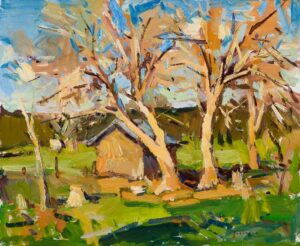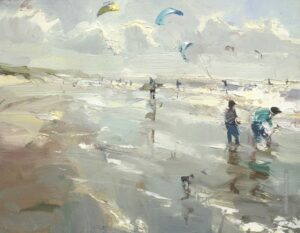I am fortunate to have been given, several years ago, some 50-70 year-old American Artist magazines. Browsing through one of them recently, I came across an article about direct painting…meaning, paintings created directly from life or nature. In light of the current fascination with, and gushing acceptance of all things done en plein air, the writer of the article brings a little sanity to the topic. I think you’ll find it helpful. All images shown in this article were done en plein air.

by John Pototschnik OPA
10″ x 20″ – Oil
“Direct painting, when practiced by an expert, gives wonderful results; it also imposes stringent rules upon those who practice it. An error of judgement may, probably will, ruin the whole work. For this reason, much knowledge must back up the brush. What must this knowledge comprise?
- The power of visualization must be developed in order that the artist may see, on the canvas, what effect he is aiming for.
- Ideas of color must be worked out before ever touching brush to canvas.
- The ability to draw, not only with the pencil but also with the brush, is mandatory.
- The ability to decide the importance of every object painted, in order to put it down in proper relationship to the whole, is a must.
- Must have a clear understanding and knowledge of masses, of tone, and of design.
“Maybe this long list of requirements will bring disappointment to many; it should not, for every true artist desires to base his work on knowledge. He can only paint what he knows. His development, therefore, depends upon the amount of knowledge he imbibes. That knowledge must be based upon close study of the moods of nature. Never, until nature is thoroughly understood, will an artist paint direct works successfully.”
by Louis Escobedo OPA
8″ x 8″ – Oil
by Eric Jacobsen
18″ x 22″ – Oil
“Nature shows her precious moods for short periods, and only the artist who understands those moods can seize upon them and put them down in paint, with certainty. That glorious period, for example, when the world is flooded with gold, just before the sun begins to set, must be understood to be painted; the artist must have observed this effect often before ever he can paint it in the time nature provides. The mind must be stored with those observations so that, when a scene presents itself opportunely under such conditions, he can set to work, backed up with the information provided by earlier study.
“Knowing the characteristics of each mood of nature enables him to apply them to any scene. If he puts down those characteristics, he has seized the mood, however roughly objects are drawn.”

by Suzie Baker OPA
10″ x 30″ – Oil
“The beauty of the subject relies not upon detailed delineation of the objects in the scene, but on the effect of a certain light upon them; hence, direct work must seize upon the object, arrangement, and effects of light, but mainly upon the last two. Nature will not allow the artist sufficient time to draw everything perfectly; indeed, if it did, detail would be so intricate that it would surely kill the fresh, pure effect the artist desires to incorporate in his work.”
“The “bloom” of color put down in one stroke and left, is something well worth striving for. Few can do it well. Success in this means certain mastery not only of brush and color, but of knowledge.”
Kapalua Bay”
by Dave Santillanes OPA
9″ x 12″ – Oil
by Roos Schuring
9.6″ x 11.8″ – Oil
by Kathleen Dunphy OPA
16″ x 20″ – Oil

by Jennifer McChristian OPA
9″ x 7″ – Gouache
How does one become an accomplished landscape painter without direct study of nature? The simple answer…you don’t. Painting and sketching directly from nature, and spending time just observing, are probably the most important habits of the landscape painter.
by Fran Ellisor
14″ x 18″ – Oil
by George Van Hook
30″ x 40″ – Oil
Here are additional benefits of creating paintings or studies when working directly from nature:
- They’re a perpetual record of where you’ve been, what you’ve directly observed, and what can always be referenced when needed. They also help recall the moment it was painted and all the circumstances involved.
- Direct observation becomes more deeply ingrained and remembered.
- They create a deeper learning experience because more time is spent observing and attempting to faithfully represent the subject.
- Compared to working from photos, more senses are involved; not only sight, but also sound, smell, and touch. Even with improved photo technology, the eyes still are able to discern subtleties that the camera cannot.
- They provide a direct interaction with the subject; it’s like speaking to someone face-to-face versus reading something someone else wrote about them.
The next step is yours…assemble your painting equipment, head outside, set up, and get after it. Your efforts, over time, will be well rewarded.







Leave a Reply